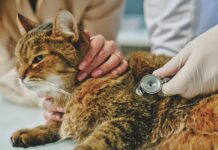Help for Musculosketal Disease A questionnaire-based tool was used in this study (“A Study of Owner Observed Behavioral and Lifestyle Changes in Cats with Musculoskeletal Disease Before and After Analgesic Therapy” in the Journal of Feline Medicine and Surgery, 2009) to identify behavioral 288 and lifestyle changes that are associated with chronic pain in cats. The changes were grouped into four behavior categories (mobility, activity, grooming and temperament). Twenty-three cats with chronic musculoskeletal pain were included. Owners of these cats were asked to complete a questionnaire before and 28 days after the start of analgesic treatment (meloxicam). A veterinary surgeon was asked to provide an independent global score before and after treatment. In this study, the baseline global scores for the veterinary assessments were very close to the owners scores, suggesting that owners were providing a useful clinical history that correlated well with the veterinary surgeons physical examination. Both owners and veterinary surgeons reported significant changes in behavior and lifestyle after analgesic therapy, with the greatest improvement in the activity category. Feline Herpes Linked to Stomatitis and Dermatitis Feline herpesvirus (FHV) is a well-known cause of upper respiratory tract disease, but less commonly, it is also associated with inflammatory oral disease (stomatitis) and dermatitis, primarily on the face. Cats with FHV dermatitis have erythema, swelling, crusting and ulceration typically around the muzzle and around the eyes. Many cases are misdiagnosed as eosinophilic granuloma complex (EGC) or another skin disease. This study (“Immunohistological Evaluation of Feline Herpesvirus-1 Infection in Feline Eosinophilic Dermatoses or Stomatitis” in the Journal of Feline Medicine and Surgery, 2010) used immunohistochemistry (IHC) and histopathology to detect the presence of FHV in biopsy samples from cats suspected of having EGC, other eosinophilic skin diseases and stomatitis. Cases were taken from samples submitted to the University of Sydney between 1996 and 2008. Of the 30 cases examined, two showed a positive reaction for FHV using IHC. In both cases, intranuclear inclusion bodies were found on histopathology, but were difficult to detect. The authors conclude that FHV is uncommonly associated with EGC or similar skin diseases in cats in Sydney, Australia. They also point out that misdiagnosis can easily occur, and FHV should be considered in cats with severe ulcerative skin lesions, especially when unresponsive to corticosteroid treatment. IHC is helpful to differentiate FHV dermatitis from other skin diseases. Inhalers for Feline Asthma Feline inflammatory bronchial diseases – such as asthma and chronic bronchitis – are common lower respiratory diseases in cats. The mainstay of therapy for inflammatory airway disease is the administration of glucocorticoids (GCs). Glucocorticoid use is indicated for the treatment of asthma and chronic bronchitis, yet glucocorticoids are associated with the potential for adverse side effects. Systemic side effects and the resultant adverse effects can be minimized with the use of topical application of glucocorticoids to the airways via an inhalational delivery system. The authors of the study (“Effects of Fluticasone Propionate Dosage in an Experimental Model of Feline Asthma” in the Journal of Feline Medicine and Surgery, 2010) investigated the ability of three different dosages of the inhalant GC fluticasone proprionate (Flovent HFA) delivered by a metered dose inhaler to ameliorate eosinophilic airway inflammation in cats with experimentally induced allergic airway inflammation. Fluticasone was administered at dosages of 44 mcg, 110 mcg or 220 mcg administered every 12 hours to six cats. All three dosage regimens of fluticasone resulted in significant amelioration of airway eosinophilia. None of the dose regimens tested caused HPAA suppression. The conclusion was that a twice-daily dose of 44 mcg fluticasone should be evaluated for the management of naturally occurring inflammatory bronchial disease in cats. This is important because fluticasone is a costly drug, and the lower strengths are less expensive than the higher strengths.



